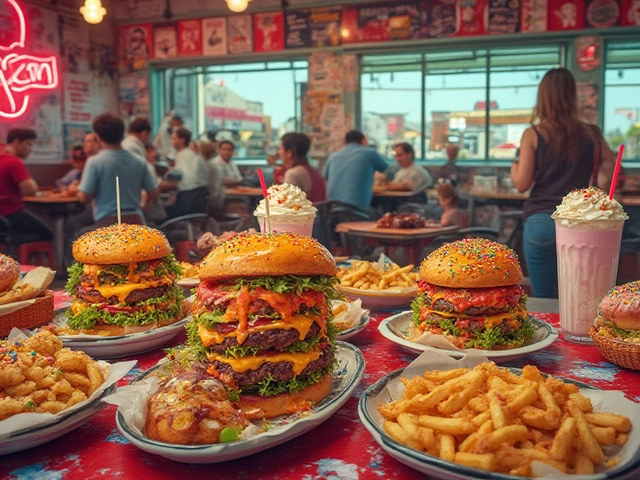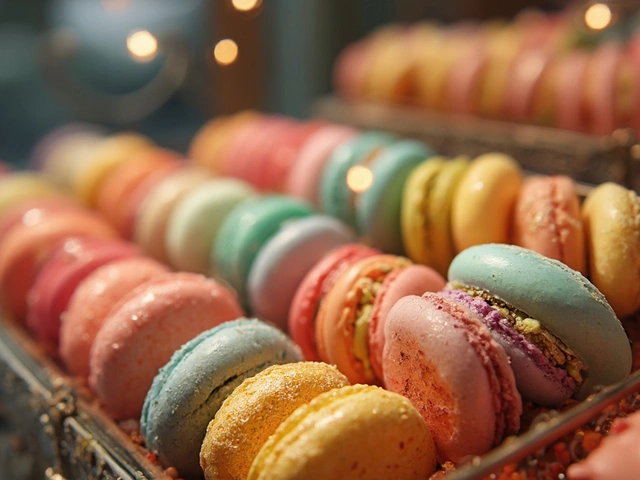
Ah, croissants—those heavenly, flaky pastries that seem to melt in your mouth. But if you're vegan, you might be giving these buttery treats the side-eye. Are croissants really vegan? Spoiler alert: they're not, at least not the traditional kind.
Traditional croissants get their rich flavor from ingredients like butter and milk, which are obviously animal-based. But don't lose hope! The vegan world is full of possibilities, and creating plant-based croissants is totally doable.
By swapping out a few ingredients, like using vegan butter and non-dairy milk, you can whip up croissants that are both tasty and cruelty-free. They might require a little extra effort in the kitchen, but the reward is worth every flaky bite.
And if you’re not much of a baker, don’t worry. Several bakeries are now offering vegan croissants, catering to those who want to enjoy their treats without compromising their values. Whether you're making them at home or buying them from a store, these vegan versions are proving that you don’t have to miss out on anything.
- Traditional Croissant Ingredients
- Why Croissants Aren't Usually Vegan
- Vegan Substitutes for Croissants
- How to Make Vegan Croissants at Home
- Where to Buy Vegan Croissants
- Tips for Enjoying Vegan Croissants
Traditional Croissant Ingredients
Getting to know what goes into a traditional croissant can be a real eye-opener, especially if you're navigating a vegan diet. These pastries may seem simple, but they're a rich tapestry of specific ingredients that come together to create that iconic flakiness and flavor.
At the heart of any croissant is the dough. The essential ingredients include:
- Flour: Typically, all-purpose flour or a mix with bread flour provides the necessary gluten to create elasticity.
- Butter: This is where croissants get their buttery layers. High-fat content butter is layered into the dough to create those perfect flakes.
- Milk: Adds richness and moisture to the dough, enhancing the overall flavor and texture.
- Yeast: This ingredient is crucial as it helps the dough rise and creates the airy, puffy structure we all love.
- Sugar: A bit of sugar adds a touch of sweetness and helps with browning.
- Salt: It’s just enough to balance the flavors without being overpowering.
The magic happens during the process of 'lamination,' where the dough is repeatedly rolled and folded with layers of butter. This crucial step is what gives croissants their light, airy, and wonderful texture. Without this intricate process, you'd just have a dense, sad roll.
The Challenge of Keeping It Vegan
The butter and milk are the primary culprits in knocking croissants off the vegan-friendly list. So, why do they use butter instead of plant-based alternatives? Quite simply, it's tradition, and the fat from butter helps achieve that perfect flaky, delicate texture croissants are known for.
Understanding these ingredients is the first step toward figuring out how to create a vegan croissant that doesn't lack flavor or texture. With a few smart substitutes, you can enjoy a plant-based version without missing out on all the goodness.
Why Croissants Aren't Usually Vegan
Croissants, loved for their flaky and tender layers, are deeply rooted in French baking traditions. However, diving into the ingredient list reveals why our beloved croissants don't fit the vegan criteria.
At the heart of a classic croissant recipe is butter. We're talking lots of it—it's what gives croissants their rich flavor and distinct texture. Butter, as you probably know, is a dairy product, derived from milk, making it a no-go for those on a vegan diet.
Next up, we've got milk. Traditional recipes often call for milk to be mixed into the dough or brushed on the pastry, contributing to a golden, appetizing crust. Just like butter, milk is also an animal-derived ingredient, bumping croissants off the vegan menu.
Other Hidden Non-Vegan Ingredients
Sometimes croissants might include other sneaky non-vegan elements like eggs, which can be used to enrich the dough or add gloss to the exterior. Eggs are clearly off the list for vegan diets.
Plus, a lot of bakeries don't stop at the plain version. Croissants get stuffed or topped with cheese, ham, or chocolate that may contain dairy—all of which are not vegan-friendly.
Breaking Down the Layers
Take a look at this rough breakdown:
| Ingredient | Often Non-Vegan |
|---|---|
| Butter | Yes |
| Milk | Yes |
| Eggs | Yes, sometimes present |
| Fillings/ Toppings | Often non-vegan (e.g., cheese, ham) |
So, if you’ve ever been frustrated standing in front of a bakery, letting that scrumptious smell make you second guess your choices, now you know why croissants typically aren’t on a vegan bakery shelf. But don't fret! The rise of plant-based diets means alternatives are on the horizon.
Vegan Substitutes for Croissants
When you think of croissants, you probably imagine the buttery layers that make this pastry so irresistible. But if you're aiming for a vegan lifestyle, those traditional ingredients won't do. Thankfully, there's a slew of vegan substitutes that can transform your pastry-making game.
Butter Alternatives
The cornerstone of a croissant is its butter. For a vegan version, you'll want to choose a plant-based butter. Look for sticks instead of tubs as they often provide a more authentic consistency for baking. Brands like Earth Balance or Miyoko's Creamery have crafted spreads that work perfectly for vegan croissant recipes.
Non-Dairy Milk
Milk is another key player in croissant recipes. But fear not, as several non-dairy milk options can step in. Almond, soy, and oat milk are all great substitutes. Pick one that’s unsweetened to keep the taste on point. And if you're after a bit of richness, oat milk is an excellent choice due to its creamy texture.
Egg Wash Alternatives
The glossy finish on a classic croissant comes from a lovely egg wash. To replicate this, opt for a mix of plant-based milk with a splash of maple syrup or agave. This swap will ensure your vegan croissants emerge from the oven with that signature sheen.
Gaining Popularity
Did you know a growing number of people are opting for plant-based diets? According to a recent study, there's been a 300% increase in the demand for vegan desserts like croissants over the past decade.
| Ingredient | Non-Vegan | Vegan |
|---|---|---|
| Butter | Dairy Butter | Plant-Based Butter |
| Milk | Cow's Milk | Almond/Oat Milk |
| Finish | Egg Wash | Plant Milk & Syrup |
So, there you have it—vegan substitutes that let you enjoy croissants without missing a beat. These swaps mean you can savor that warm, flaky goodness, knowing you're sticking to your vegan values.

How to Make Vegan Croissants at Home
Ready to get your hands on some flaky, delicious vegan croissants? It's kitchen time! Making vegan croissants at home is super rewarding, and once you nail it, you'll never want to stop. Let’s break it down into easy steps so you can enjoy these plant-based delights right from your oven.
Gathering Your Ingredients
First things first, here’s what you’ll need:
- Vegan butter (make sure it’s firm enough for rolling)
- All-purpose flour
- Sugar
- Salt
- Instant yeast
- Non-dairy milk (like almond or soy)
- Water
Prepping the Dough
Let’s dive into the dough. Mix the flour, sugar, salt, and yeast in a large bowl. Gradually add the non-dairy milk and water, stirring until it forms a rough dough. Knead for about 10 minutes till it's smooth and elastic. Now, let it rest for at least an hour until it doubles in size.
Creating the Vegan Butter Block
This part is crucial. Take your firm vegan butter and shape it into a flat block, about 1/2 inch thick. Wrap it in parchment paper and refrigerate till solid.
Laminating the Dough
Now comes the fun (and slightly messy) part! Roll the dough into a rectangle and place your chilled butter block on one half. Fold the dough over the butter and seal the edges. Roll and fold the dough three more times, refrigerating if the butter becomes too soft.
Shaping the Croissants
Once you're done with laminating, roll the dough into a large rectangle. Cut it into triangles, then gently roll each from the wide end to form that classic crescent shape.
- Let the shaped croissants rise for another hour till puffy.
- Brush them with extra non-dairy milk for a golden touch.
- Bake at 375°F for about 20 minutes or until golden and flaky.
Enjoy Your Croissants
There you have it! Your homemade vegan croissants are ready to impress. Awesome with a cup of coffee or as a filling snack, they’re a worthwhile baking adventure.
Where to Buy Vegan Croissants
Finding vegan croissants might seem like a tricky task, but it's way easier than you might think! Thanks to the rise of plant-based diets, more bakeries are stretching their boundaries and venturing into vegan pastries. So, get ready to track down some flaky, cruelty-free goodness.
Local Bakeries
Your first stop should be local bakeries. Many modern bakeries now offer vegan options due to increasing demand. It's always best to call ahead and ask, since not all of them update their websites regularly. You'll often find that they have these vegan bakery delights hidden among other pastries.
Specialty Vegan Stores
Another option is checking out stores that specialize in vegan products. They frequently carry vegan baked goods from various local craftspeople. These shops can be a goldmine, packed with more than just croissants!
Online Platforms
There are also online platforms where you can order vegan croissants from vegan-centered bakeries. Sites like Vegan Essentials or The Vegan Bakery deliver pastries right to your door, which is great if you're short on time or don't have a local bakery nearby.
Supermarkets
Believe it or not, supermarkets have begun to catch on too. Chains like Whole Foods often stock vegan pastries in their bakery department. It's worth checking the labels, though, just to be sure.
Popular Vegan Bakeries
To make it easier, here's a quick rundown of a few popular vegan bakeries known for their croissants:
- Champs Bakery in New York
- Cinnaholic in various cities
- Hot Bread Kitchen in the East Coast
Whether you're a home baker or prefer letting the professionals handle it, enjoying vegan croissants is more accessible than you might imagine. Just a little bit of research can lead to a game-changing, guilt-free pastry experience!
Tips for Enjoying Vegan Croissants
Ready to dive into the world of vegan croissants? You're in for a treat! Whether homemade or store-bought, these tips will help you get the most out of every flaky, plant-based bite.
Freshness is Key
There's nothing quite like a freshly baked croissant. If you're making them at home, bake only what you plan to eat within a day or two. This ensures they remain crispy and delightful. If you're buying, ask when they were made. Fresher is always better.
Pair it Right
Pairing your vegan croissant with the right drink can elevate the experience. A classic pairing is a well-brewed cup of coffee or a frothy almond milk latte. The subtle flavors of the drink can complement the buttery taste of the croissant.
Savor the Flavors
Don't rush through them; take the time to savor the flaky layers. Each bite should be an experience. If you're exploring different flavors, like chocolate or almond vegan croissants, discover how the filling works with the pastry.
Accessorize Your Croissant
Just like regular croissants, vegan croissants can play well with jams, spreads, or even some plant-based cheese. Try spreading a thin layer of your favorite fruit preserve or a dollop of almond butter for a delicious twist.
Store Smartly
If you've got leftovers (though that's rarely the case), store them in a paper bag at room temperature for a day. For longer storage, freeze them in an airtight container. Reheat frozen croissants in the oven to bring back their crispiness.
Explore Different Types
The vegan pastry world is creative, and bakeries often experiment with exciting flavors. From matcha to saffron-infused croissants, don't hesitate to try something new!
Enjoying vegan croissants can be a delightful adventure. With the right approach, they're just as enjoyable as their traditional counterparts—sometimes even more!





